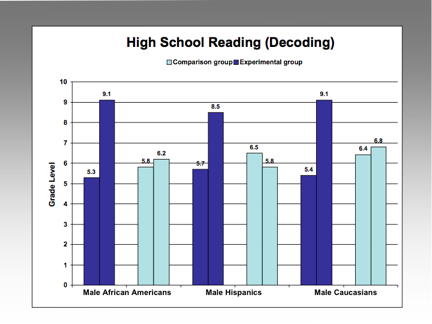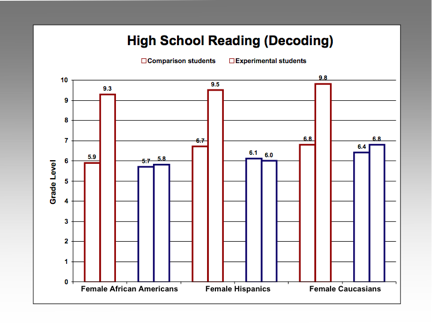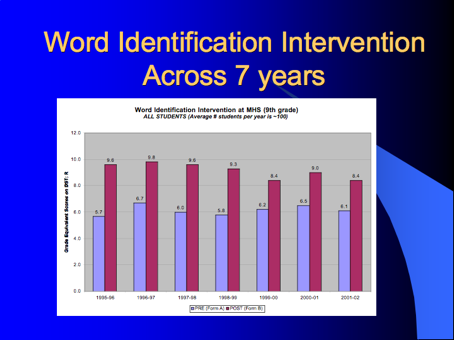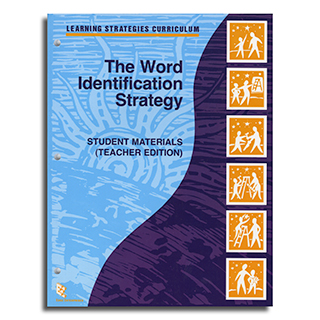Description
Research on the Word Identification Strategy
Study 1
Overview
The Word Identification Strategy is comprised of a set of steps students use to decode multisyllabic words, like the words they find in secondary science and social studies textbooks. Twelve students with LD in grades 7, 8, and 9 participated in this study. At the beginning of the study, their reading scores on a standardized test ranged from the third to seventh grades. The study employed a multiple-baseline across-subjects design. All participants were taught the strategy.
Results
During baseline (before instruction), on a test of oral decoding, the students made as many as 21 errors as they were reading 400-word passages written at their ability level and 37 errors as they were reading passages written at their grade level. After instruction in the strategy, all students reached the mastery requirement of 6 or fewer errors in a 400-word passage within 5 practice trials when reading ability-level passages and within 9 trials when reading grade-level passages. At the end of the study, they made an average of 5 errors as they were reading 400-word passages taken from subject-area textbooks for their grade level.
During baseline, the students’ average comprehension scores were 83% on ability level passages and 39% on grade-level passages. After instruction, their average comprehension scores were 88% on ability level passages and 58% on grade-level passages.
Maintenance tests taken as many as five weeks after instruction had ended showed that the students maintained their use of the strategy and continued to commit fewer oral reading errors than they had before instruction.
Conclusions
After instruction in the Word Identification Strategy, students made substantially fewer decoding errors when reading a passage written at their ability and grade levels than they did before instruction. On average, their comprehension scores increased. However, some students did not realize substantial comprehension score increases.
Reference
Lenz, B.K. and Hughes, C.A. (1990). A Word Identification Strategy for learning disabled adolescents. Journal of Learning Disabilities, 23(3), 149-158, 163.
Study 2
Overview
The purpose of this study was to evaluate the effects of instruction in the Word Identification Strategy on a diverse group of adolescents, some of whom were eligible for special education services. Two matched groups of 62 ninth graders who attended two matched high schools and who had earned decoding scores of two or more grades below their grade level on a standardized decoding test, were involved. Included in the experimental group were 11 students with LD. Many of the students were living in poverty. Both groups included African Americans and Hispanics, as well as Caucasians. The experimental group received instruction in the Word Identification Strategy for 4 to 8 weeks, depending on how much time was required for each student to reach mastery. Students were pulled out of their language arts classes in small groups of 4 to 6 students for the instruction for one hour per day until they met mastery. The comparison group received traditional reading instruction during the school year. All students were tested at the beginning and end of the study using the Slossen Diagnostic Battery (Gnagey & Gnagey, 1994) to obtain a decoding score.
Results
The results showed that ninth-grade students in the experimental school were decoding, on average, at the high fourth-grade level when they entered high school. Seven months later, after the experimental students had received instruction in the Word Identification Strategy, the experimental students were decoding, on average, at the high eighth-grade level, a mean grade-level improvement of 3.4 grade levels. Every student made an improvement of at least .8 grade levels. The eleven students with LD made a mean grade-level improvement of 3.9 grade levels in decoding (range = .8 to 6.1 grade levels). The average decoding level at the beginning of the study for the students with LD was at the 4.9 grade level and at the end of the study was at the 8.8 grade level.
The comparison students made little improvement. At the beginning of the study, they were decoding, on average, at the 6.1 grade level. Seven months later, they were decoding, on average, at the 6.3 grade level, for an average gain of .2 grade levels (range= .1 to 1.7 grade levels). (See Figures 1 and 2, where each pair of bar graphs represents the average pretest and posttest grade level decoding scores. Figure 1 depicts the mean scores for male students; Figure 2 depicts the mean scores for female students.)
Figure 1: Mean grade-level decoding scores for male students

Figure 2: Mean grade-level decoding scores for female students

ANCOVA results indicated that there was a significant difference between the posttest raw decoding scores of the experimental and comparison groups [F(1,121) = 31.078, p <.001, η2 = .692] when the pretest scores served as the covariate. (This represents a large effect size). In addition, there was a significant difference between the posttest scores of students with LD in the experimental group and the posttest scores of comparison students who were matched with the students with LD in the experimental group on the basis of their pretest scores [F(1, 19) = 29.673, MSE = 43.93, p < .001, η2 = .610]. (This also represents a large effect size.) However, the most significant finding was that, at the end of the study, the students in the experimental group were decoding, on average, at the ninth-grade level, their actual grade level. The experimental students with LD were decoding at the high eighth-grade level (8.8), very close to their actual grade level. The results for all subgroups of students representing all the minorities, mirrored the results for the whole groups. Furthermore, the authors reported that the same kind of results have been achieved by the school decoding program for eight years running. (See Figure 3 where the blue bars represent pretest scores and the maroon bars represent posttest scores.)
Figure 3: Pretest and posttest grade-level decoding results across school years

Conclusions
Instruction in the Word Identification Strategy, when implemented with small groups of students in an intensive way, can result in “closing the gap” for them with regard to being able to decode multisyllabic words at their grade level. Substantial increases were achieved with all subgroups of students including students with reading disabilities. Comparison students did not make gains in decoding.
Reference
Woodruff, S., Schumaker, J. B., & Deshler, D. D. (2002). The effects of an intensive reading intervention on the decoding skills of high school students with reading deficits. (Research Report No. 15). Lawrence, KS: University of Kansas Center for Research on Learning.










